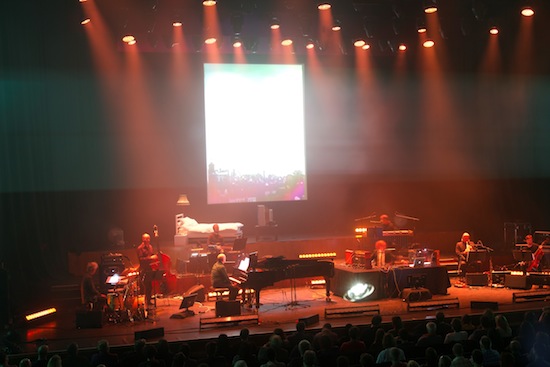Every few minutes an Oblique Strategy card shuffles into view on two large screens positioned at either end of the Barbican Hall. In the far corner of the stage is a simple bed and bedside table setup – a knowing nod to the hospital room where Brian Eno first conceived of the style that would become his calling card. It’s a slightly bizarre concept to repurpose ambient music as a thing to be looked at. “I was trying to make a piece that could be listened to and yet could be ignored,” writes Eno in the liner notes for Discreet Music, “perhaps in the spirit of Satie who wanted to make music that could ‘mingle with the sound of the knives and forks at dinner.’”
With Discreet + Oblique: The Music of Brian Eno, musical directors, David Coulter and Leo Abrahams, have set themselves the monumental task of reimagining a defining piece of music. Translating it from a mechanised production into an organic one was a brave move in the first place, but to stage it in such a spectacular manner – to stage it at all – forcing focus upon sound intended to blend feels like rewriting Mrs. Dalloway in a linear narrative. However, from the first inaudible notes, any doubts about the performance dissipate immediately. Whilst the methods may be different, Eno’s ethos is evident in the caution and subtlety with which each of the nine-strong ensemble approach their roles.
To employ a much abused phrase: it is an immersive experience. Organ drones rumble up through the floorboards, buzzing around ears and nuzzling in bellies. The musicians manoeuvre their instruments around the A-side’s skeletal framework, chewing on snatches of melody and adding flesh to the bones. The respective trios of jazz and classical musicians are fed through Frippertronic looping system and EMS synthesizer – the closest approximation to the machines used by Eno in the original. Benge processes the noise like an alchemist at an apothecary table. Through his loops and layers he magnifies the song’s delicate fluctuations, transforming the auditorium into a great, pulsing shell. Even the tiniest noise becomes an essential fragment of the undulating whole – the crack and pop of a plastic pint cup being squeezed; the shuffle of uncrossing legs; a cough, a sniff, a glottal swallow; the perpetual whirring of Frippertronics, or that might just be the air-conditioning. In the audience heads droop in a hypnotic half-sleep, borne along on the rise and fall of the rise and fall. A series of subtractions brings the first half into a systematic descent, waning in gasps until the lights come up.
Following a short intermission, the ensemble launches into Gavin Bryars’ galvanized arrangements for Discreet Music’s B-side – ‘Three Variations On The Canon In D Major By Johann Pachelbel’ – and it’s not long before the ensemble’s interpretation descends into an electrified maelstrom. Coulter himself takes to the spotlight, eking out a solo on musical saw. A scuffle breaks out stage-left, as Australian jazz trio The Necks lose themselves in improvised madness. Lloyd Swanton slaps his double bass like he’s playing a game of whack-a-mole, whilst drummer Tony Buck goes ape-shit on his kit, kicking out all manner of rhythms with all manner of objects. A schism of melodies burst into life on the opposite side, with violin, cello and clarinet all heading off on separate tacks as the fracas of moving bodies raises a merry hell within the confines of Pachelbel.
Oblique Strategies are coming in thick and fast on the projector screens, each one prompting a sharp change in action, timbre and tempo; ‘Think of the radio’; ‘Change instrument roles’; ‘Emphasise differences’; ‘Don’t be ashamed of using your own ideas’. The stratagems add a narrative that throws sharper focus on the musicians’ responses to the composition, as well as the fluidity of the compositions themselves. As the figures on stage once again pilot their instruments into a harmonious decline the final card flashes up: ‘How would you have done it?’
If Discreet Music offered a new way of hearing to music, then Discreet + Oblique offers of new way of listening to it. The performance feels like an exercise in chaos theory, where the slightest alteration of a foundational element could render a new work entirely. The developments made to Eno’s work by these musicians is overwhelming, it’s immediacy and extemporaneity turning a tribute into this bright, shiny new thing. Even more overwhelming is to consider the ways in which it could’ve been different if it was tackled by different musicians, or with a different set of Oblique Strategies, or even if the cellist had slept on his neck funny. The scope of this project is, in theory, infinite.


